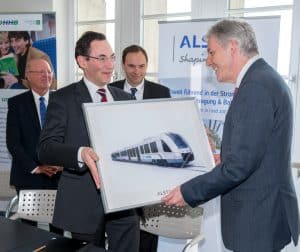Trains running on hydrogen could be used in the future as an alternative to diesel-driven railcars on non-electrified parts of the railroad system. Although railroad cars with fuel cell-battery engines still cost up to a million euros more than today’s diesel models, the efficiency gains of fuel cells and the lower maintenance requirements could lead to cost savings of 25% over the medium term, an economic analysis found. The first tests of the new technology are said to be conducted in the German states of Lower Saxony and Hesse.
After Alstom had already announced in 2015 that it intended to put fuel cell trains to the test (see Hydrogenics, Alstom and H2 Trains), the French corporation reported that it would present an H2 railcar at the InnoTrans, the leading trade show for transportation technology, in September 2016. It also said during a trade conference in Lower Saxony that the first test track would be one in the rural district of Stade. The pilot-stage version of the railcar is based on Model 54 of the Coradia LINT family of railroad vehicles for inter-city lines and could run from Buxtehude via Bremervörde and Bremerhaven to Cuxhaven starting in 2018. If the test runs are successful, there could be a total of 50 to 60 units in daily operation by 2021.
Based on calculations by Jens Sprotte, business development manager at Alstom, such a fleet of fuel cell-driven LINT 54 trains will require …
BMVI study on fuel cell trains
The results of another study, for which NOW commissioned the German branch of the Ernst & Young accounting firm on behalf of the BMVI, complemented the ones of the first study perfectly. It showed that hydrogen technology did not place any restrictions on railroad operations. The research accompanying the project also pointed to a notable reduction in diesel emissions. “Towards zero emissions in rail transport,” yet another study conducted from the end of 2015 to March 2016, analyzed the infrastructure requirements for the use of fuel cell railroad cars in Germany in collaboration with partners such as Ludwig Bölkow Systemtechnik and Becker Büttner Held.
When the study findings were presented, the state secretary at the German transport ministry, Rainer Bomba, explained: …
Representatives from other German states (Hesse – see box below, North Rhine-Westphalia, Baden-Württemberg) are meanwhile thinking about utilizing it as well.
H2 railroad cars in Hesse
From 2020 on, Rhein-Main-Verkehrsverbund intends to use up to 20 fuel cell-run regional trains in the Taunus network. Tracks for test runs in Hesse could be the German railroad hub of Frankfurt a. M. Main Station to final stops in the Taunus region. The relevant lines have already been running right next to the Höchst industrial park, where chemical plants generate large amounts of hydrogen.
A feasibility study commissioned by HA Hessen Agentur and completed at the end of 2015 found the …
A first cost estimate put the investment in the low or mid-range of a two-digit million figure for realizing a suitable refueling infrastructure, including the required track system. This investment could pay off within a few years because of the expected (and comparably high) hydrogen consumption of up to four tons a day, even if the price of hydrogen remained below ten euros per kilogram. What has not yet been included in the calculation are possible subsidies granted by the European Union and / or the German federal government.
More details were released in September at the InnoTrans and in October at the World of Energy Solutions in Stuttgart.



























0 Comments